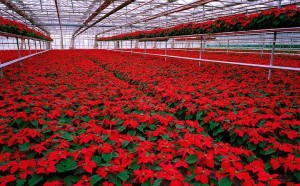
Why Poinsettias at Christmas?
 Ever wonder how poinsettias evolved into the undisputed flower of Christmas? The plant’s association with Christmas also began in Mexico in the 16th century and centered on a legend of a poor girl who, unable to provide a gift for Jesus’s birthday, picked “weeds” at the side of the road that then blossomed into the beautiful red poinsettia. Beginning in the 17th century, Franciscan friars in Mexico included the plants in their Christmas celebrations. The star-shaped leaf pattern is said to symbolize the Star of Bethlehem, and the red color represents the blood sacrifice through the crucifixion of Jesus.
Ever wonder how poinsettias evolved into the undisputed flower of Christmas? The plant’s association with Christmas also began in Mexico in the 16th century and centered on a legend of a poor girl who, unable to provide a gift for Jesus’s birthday, picked “weeds” at the side of the road that then blossomed into the beautiful red poinsettia. Beginning in the 17th century, Franciscan friars in Mexico included the plants in their Christmas celebrations. The star-shaped leaf pattern is said to symbolize the Star of Bethlehem, and the red color represents the blood sacrifice through the crucifixion of Jesus.
Poinsettias are native to Mexico and were introduced to the United States in 1825 by Dr. Joel Robert Poinsett, the first U.S. ambassador to Mexico, who dabbled in botany and sent cuttings back to his home in South Carolina. Today, poinsettias represent 85% of holiday season potted plant sales and are the best-selling flowering potted plant in the U.S. even though most are sold in only a six week period!
Three-to-six bloom red poinsettias are the most popular but poinsettias come in several other sizes, shapes and colors. Natural colors for poinsettias can range from creamy white to shades of pink and orange to the traditional red. Also available are marbled bracts of pink and white as well as pink flecks on red. You may see poinsettias in other more exotic colors but these plants are dyed, rather than natural.
Contrary to popular belief, Poinsettias are NOT poisonous. The milky sap from the stem can, however, cause minor skin irritation or mild stomach upset in pets or people.